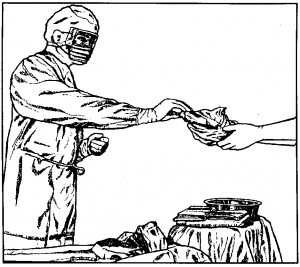a. The principles of sterile technique are applied in various ways.
In the following paragraphs, the principles of sterile technique and examples of their application are discussed. When the OR specialist understands the principles, he should be aware of other examples of their application.
b. All materials used as a part of the sterile field for an operation must be sterile.
Certain basic items (such as the linen, the instrument set, and the basins) may be obtained from the supply kept in the sterile supply room. Others, such as specialized surgical instruments, may be sterilized the night before or immediately preceding the operation and taken directly from the sterilizer to the sterile operative field. Once an item is removed from a sterile wrapper, it must be used or discarded.
(1) Linen used in the operating room is usually dyed green. This helps to reduce the glare from lights, thus reducing fatigue and eyestrain.
(2) Linen selected for use in the operating room should be checked to ensure that the linen is not torn or frayed and that no holes are present in the cloth. Likewise, it should be handled gently to prevent lint and dust from being spread about the room.
(3) Only materials known to be sterile should be used and their sterility should be maintained throughout the operative procedure.
(4) Sterile areas are set up just prior to use.
(5) Scrub attire should not be worn outside the surgical suite.
(6) All team members should wash hands before and after the care of each patient.
c. Items should be considered unsterile if there is doubt about their sterility.
(1) If a sterile-appearing package is found in an area not designated for sterile storage, it is considered unsterile and must be reprocessed and re-sterilized.
(2) If there is doubt about the timing of a sterilizer, its contents are considered unsterile.
(3) If an “unsterile” person brushes close to a sterile table, the table is considered contaminated. Also, if a “sterile” person brushes close to an unsterile table, the person’s sterile gown is considered contaminated.
(4) If a sterile table or sterile items are left unmonitored, the table and items are considered unsterile.
(5) Do not drop or place clean supplies on the floor. Do not drop or place used supplies or soiled linen on the floor.
d. Only the top surface of a draped table is considered sterile.
Anything extending over the edge or hanging over the edge is not sterile.
(1) Linen or sutures falling over the edge of the table should be discarded. The scrub should not touch the part hanging below the table level.
(2) When the scrub drapes a table with sterile linen, he should see that the part of the linen that drops below the table’s surface is not brought up to table level again.
e. Once again, neither the circulator nor the scrub may intrude upon the other’s area at any time, although it is very important that they consult with each other and that each is aware of what the other is doing.
The duties performed by the scrub and by the circulator are governed by specific procedural rules. Persons who are “sterile” touch only sterile articles; “unsterile” persons touch only unsterile items. All supplies for the “sterile” team members (scrub, surgeon, and assistants) are provided by the circulator (“unsterile” team member) who protects the sterility of items through the use of the wrappers on sterile packages (see Figure 1-1). These procedures are described in paragraphs f and g below.
NOTE: In Figure 1-1, observe how the circulator handles the sterile wrapper and the distance he stands from the sterile field.

